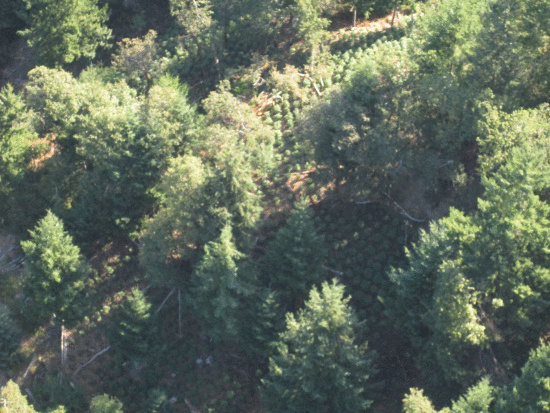
Aerial view of marijuana grow in the Six Rivers National Forest near the eastern Humboldt County border.
Part one of a series of articles about how marijuana grows affect the environment: First, the description of a marijuana garden on public land. Who grew it and what was found.

On August 13th of this year, a team of law enforcement from a hodgepodge of agencies (Humboldt and Trinity County Sheriff’s Offices, US Forest Service, and CERT—the Cannabis Eradication and Reclamation Team,) poured over a ridge a couple miles west of the tiny hamlet of Hyampom (a place so rural that there is literally only one gas pump in over 400 square miles.) There, just inside the Humboldt Co. line in the Six Rivers National Forest, they captured one resident of Michoacan, Mexico with a loaded 9 mm semi-automatic handgun, and they eradicated 5266 marijuana plants.
The plants were small—one to four feet in height. The suspect, Andres Montes-Deoca, was young—only 21—but already he had been deported to Mexico once before. The site was old—it had been grown at least once before. In 2007, over 134,000 plants were cleared from the area. This was the largest bust ever in Humboldt County and, at the time, it took four days to clear the plants out.
This year’s plants were removed more quickly. The final buds ascended like sacrificial offerings into the sky trailing beneath the belly of a helicopter only to settle back to earth and be disposed of a short while later. And, when the last of law enforcement trudged up the trail, the marijuana removed and disposed of, the camp lay mostly intact within the shadow of the forest…
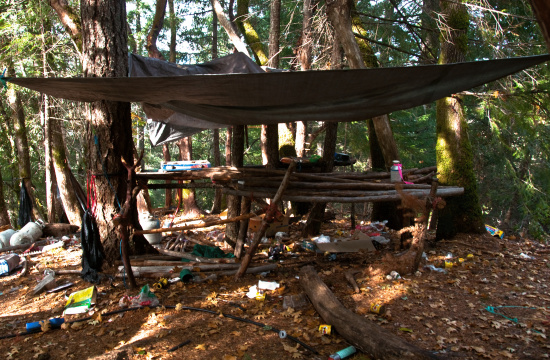
All photos taken nearly three months after the August 13th raid after wild animals had torn apart the trash and supplies and debris had fallen from trees.
A half an onion rested in a bowl in the kitchen formed of tree bark and cheap supplies,
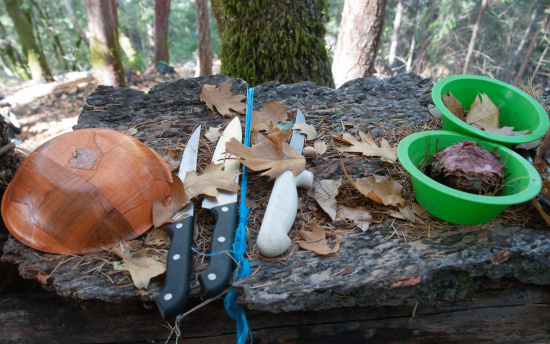
and a sleeping bag spread over a green cot.
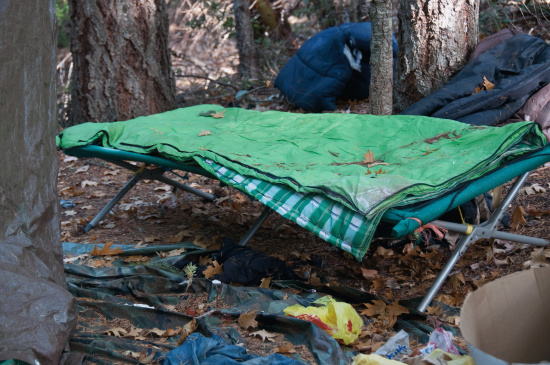
In the coming months, the tangle of tin cans that hung from thin plastic rope would jangle warnings about the encroachments of wild animals but no human would hear their sound.
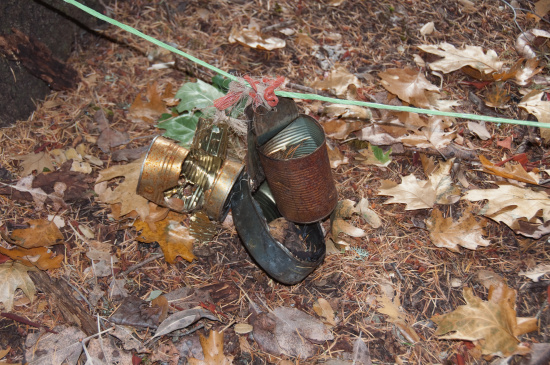
From August til November, creatures would tear apart the supplies—scatter the bags of beans and rip open the canned goods.
Bears and raccoons would unearth and slash trash bags tucked into hiding spots and spread their contents in ugly abandon across rocks carpeted in rich green moss and soil covered in needles and leaves.
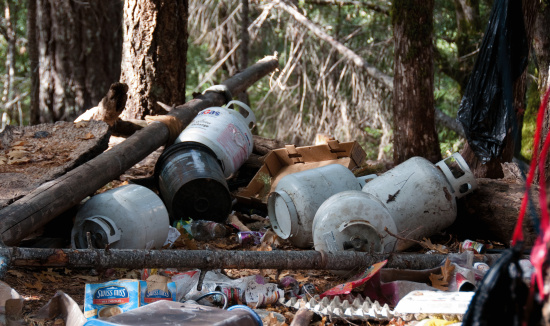
Propane tanks used to fuel the camp stove lie amidst scattered trash.
In spite of the trash, in many ways, the camp was a Tom Sawyer dream for boys playing at being castaways from society. Slender tree trunks are lashed together to make various items. A tarp, some trees, some containers, a camp stove and a slab of bark create a kitchen. Sling shots
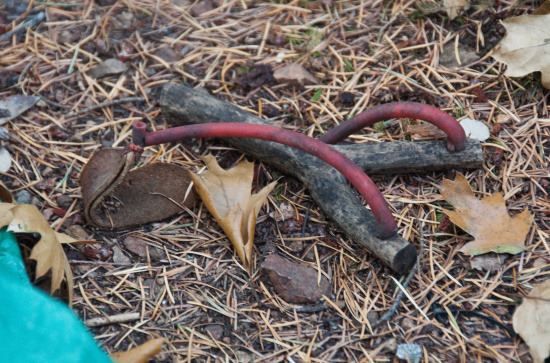
and pellet guns offer entertainment for would-be Huck Finns. Reservoirs made of tarps and lashed together logs gathered water from secret underground springs.
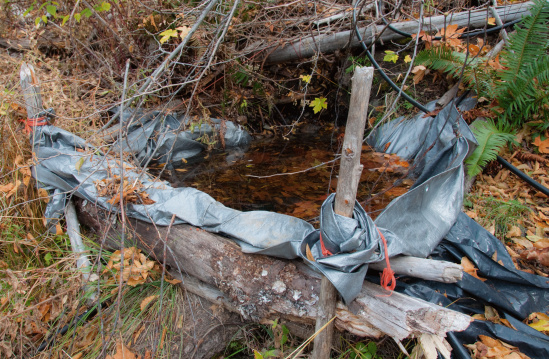
The gathered water was funneled to various gardens terraced in the hillsides where it sprayed from overhead sprinklers on nearly 5,300 marijuana plants.
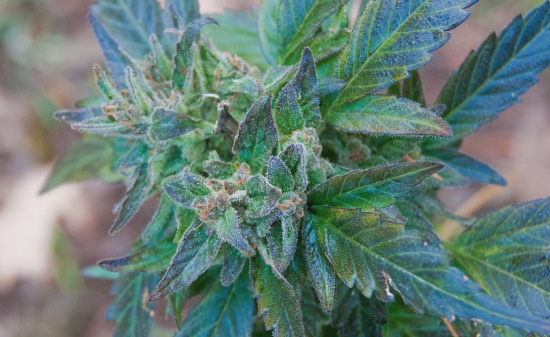
A couple branches here and there escaped law enforcement’s notice and continued to grow into November.
(Street value at harvest is hard to to quantify but possibly close to a million dollars could have been brought out of the garden. Aerial photos from 2012 reveal that the garden was grown then also and probably brought in a tidy sum.)
This year oak trees partially hacked down for the earlier grow still poked slender fractured trunks like mutilated fingers into the air.

Back at camp, playing cards sprawl in a tray near a cot. The tray carried young marijuana plants into the forest and now it holds empty whippets (small silver canisters containing nitrous oxide often inhaled for a quick high) as well as dried leaves.
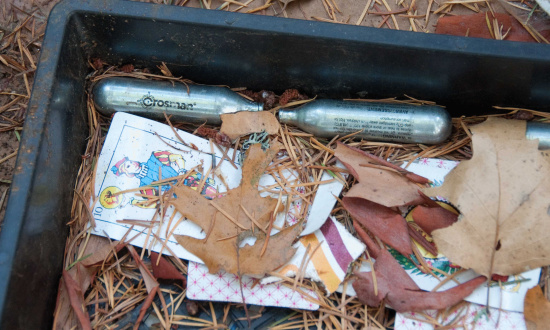
But more than bringing cheap thrills and trash to the national forests, the inhabitants of this camp brought poison.
Among the items left behind was a long list of toxicants.
- malathion
- aluminum phosphide
- beta-cyfluthrin
- strychnine
- brodifacoum
- bromadiolone
- carbaryl naphthyl methylcarbamate
- gamma cyhalothrin
Three of the chemicals found at the site are pictured below. Some containers were punctured by animal teeth and the contents possibly ingested. The middle chemical, aluminum phosphide is restricted to use by a certified applier and can be lethal to humans as well as wildlife.
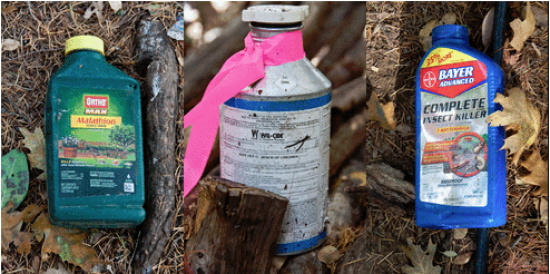
Look for part two which will explore the poisons and their effect on wildlife.
CLICK TO MANAGE